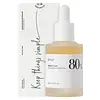What's inside
What's inside
 Key Ingredients
Key Ingredients

 Benefits
Benefits

 Concerns
Concerns

No concerns
 Ingredients Side-by-side
Ingredients Side-by-side

Centella Asiatica Extract 76.38%
CleansingButylene Glycol
HumectantGlycerin
HumectantWater
Skin ConditioningPropanediol
Solvent1,2-Hexanediol
Skin ConditioningNiacinamide
SmoothingDipropylene Glycol
HumectantGlycereth-26
HumectantCarbomer
Emulsion StabilisingArginine
MaskingHydroxyethyl Acrylate/Sodium Acryloyldimethyl Taurate Copolymer
Emulsion StabilisingAllantoin
Skin ConditioningEthylhexylglycerin
Skin ConditioningAdenosine
Skin ConditioningSodium Hyaluronate
HumectantDisodium EDTA
Polysorbate 60
EmulsifyingSorbitan Isostearate
EmulsifyingCynanchum Atratum Extract
Skin ConditioningGlyceryl Acrylate/Acrylic Acid Copolymer
HumectantLactobacillus Ferment
Skin ConditioningHydroxypropyltrimonium Hyaluronate
Vitis Vinifera Fruit Extract
Skin ConditioningCaprylic/Capric Triglyceride
MaskingLespedeza Capitata Leaf/Stem Extract
Skin ConditioningMacadamia Ternifolia Seed Oil
EmollientDiospyros Kaki Leaf Extract
Skin ProtectingAlcohol
AntimicrobialPolygonum Cuspidatum Root Extract
AntioxidantCoffea Arabica Seed Extract
MaskingCarthamus Tinctorius Flower Extract
Skin ConditioningEpilobium Fleischeri Extract
Skin ConditioningHydrogenated Lecithin
EmulsifyingZanthoxylum Piperitum Fruit Extract
Skin ConditioningCastanea Crenata Shell Extract
Skin ConditioningCamellia Sinensis Leaf Extract
AntimicrobialPolysorbate 20
EmulsifyingRetinol
Skin ConditioningAsiaticoside 0%
AntioxidantMadecassic Acid 0%
Skin ConditioningHydrolyzed Hyaluronic Acid
HumectantBrassica Campestris Sterols
EmollientSodium Acetylated Hyaluronate
HumectantAsiatic Acid 0%
Skin ConditioningCholesterol
EmollientHyaluronic Acid
HumectantCeteth-5
EmulsifyingCeteth-3
EmulsifyingTocopheryl Acetate
AntioxidantAluminum/Magnesium Hydroxide Stearate
Emulsion StabilisingHydrolyzed Sodium Hyaluronate
Skin ConditioningPotassium Cetyl Phosphate
EmulsifyingSodium Hyaluronate Crosspolymer
HumectantProtease
ExfoliatingPapain
Skin ConditioningChitosan
Citric Acid
BufferingLipase
Skin ConditioningPotassium Hyaluronate
Skin ConditioningCentella Asiatica Extract 76.38%, Butylene Glycol, Glycerin, Water, Propanediol, 1,2-Hexanediol, Niacinamide, Dipropylene Glycol, Glycereth-26, Carbomer, Arginine, Hydroxyethyl Acrylate/Sodium Acryloyldimethyl Taurate Copolymer, Allantoin, Ethylhexylglycerin, Adenosine, Sodium Hyaluronate, Disodium EDTA, Polysorbate 60, Sorbitan Isostearate, Cynanchum Atratum Extract, Glyceryl Acrylate/Acrylic Acid Copolymer, Lactobacillus Ferment, Hydroxypropyltrimonium Hyaluronate, Vitis Vinifera Fruit Extract, Caprylic/Capric Triglyceride, Lespedeza Capitata Leaf/Stem Extract, Macadamia Ternifolia Seed Oil, Diospyros Kaki Leaf Extract, Alcohol, Polygonum Cuspidatum Root Extract, Coffea Arabica Seed Extract, Carthamus Tinctorius Flower Extract, Epilobium Fleischeri Extract, Hydrogenated Lecithin, Zanthoxylum Piperitum Fruit Extract, Castanea Crenata Shell Extract, Camellia Sinensis Leaf Extract, Polysorbate 20, Retinol, Asiaticoside 0%, Madecassic Acid 0%, Hydrolyzed Hyaluronic Acid, Brassica Campestris Sterols, Sodium Acetylated Hyaluronate, Asiatic Acid 0%, Cholesterol, Hyaluronic Acid, Ceteth-5, Ceteth-3, Tocopheryl Acetate, Aluminum/Magnesium Hydroxide Stearate, Hydrolyzed Sodium Hyaluronate, Potassium Cetyl Phosphate, Sodium Hyaluronate Crosspolymer, Protease, Papain, Chitosan, Citric Acid, Lipase, Potassium Hyaluronate
 Reviews
Reviews

Ingredients Explained
These ingredients are found in both products.
Ingredients higher up in an ingredient list are typically present in a larger amount.
1,2-Hexanediol is a synthetic liquid and another multi-functional powerhouse.
It is a:
- Humectant, drawing moisture into the skin
- Emollient, helping to soften skin
- Solvent, dispersing and stabilizing formulas
- Preservative booster, enhancing the antimicrobial activity of other preservatives
Arginine is an amino acid that is important for human development. Your body uses is it to produce hair keratin and skin collagen.
As a cosmetic ingredient, Arginine has antioxidant properties and can also help repair damaged skin. This ingredient is derived either synthetically or from animals.
Arginine isn't fungal acne safe when used in the presence of other lipids (fats, fatty acids, oils, esters, etc). Oils and fats occur naturally within the skin, so take caution when using Arginine if you're prone to fungal acne.
Learn more about ArginineButylene Glycol (or BG) is used within cosmetic products for a few different reasons:
Overall, Butylene Glycol is a safe and well-rounded ingredient that works well with other ingredients.
Though this ingredient works well with most skin types, some people with sensitive skin may experience a reaction such as allergic rashes, closed comedones, or itchiness.
Learn more about Butylene GlycolCarbomer is a polymer of acrylic acid. Its main role is to create a gel consistency.
A high amount of carbomer can cause pilling or balling up of products. Don't worry, most products contain 1% or less of carbomer.
Ethylhexylglycerin (we can't pronounce this either) is commonly used as a preservative and skin softener. It is derived from glyceryl.
You might see Ethylhexylglycerin often paired with other preservatives such as phenoxyethanol. Ethylhexylglycerin has been found to increase the effectiveness of these other preservatives.
Glycerin is already naturally found in your skin. It helps moisturize and protect your skin.
A study from 2016 found glycerin to be more effective as a humectant than AHAs and hyaluronic acid.
As a humectant, it helps the skin stay hydrated by pulling moisture to your skin. The low molecular weight of glycerin allows it to pull moisture into the deeper layers of your skin.
Hydrated skin improves your skin barrier; Your skin barrier helps protect against irritants and bacteria.
Glycerin has also been found to have antimicrobial and antiviral properties. Due to these properties, glycerin is often used in wound and burn treatments.
In cosmetics, glycerin is usually derived from plants such as soybean or palm. However, it can also be sourced from animals, such as tallow or animal fat.
This ingredient is organic, colorless, odorless, and non-toxic.
Glycerin is the name for this ingredient in American English. British English uses Glycerol/Glycerine.
Learn more about GlycerinSodium Hyaluronate is hyaluronic acid's salt form. It is commonly derived from the sodium salt of hyaluronic acid.
Like hyaluronic acid, it is great at holding water and acts as a humectant. This makes it a great skin hydrating ingredient.
Sodium Hyaluronate is naturally occurring in our bodies and is mostly found in eye fluid and joints.
These are some other common types of Hyaluronic Acid:
Learn more about Sodium Hyaluronate